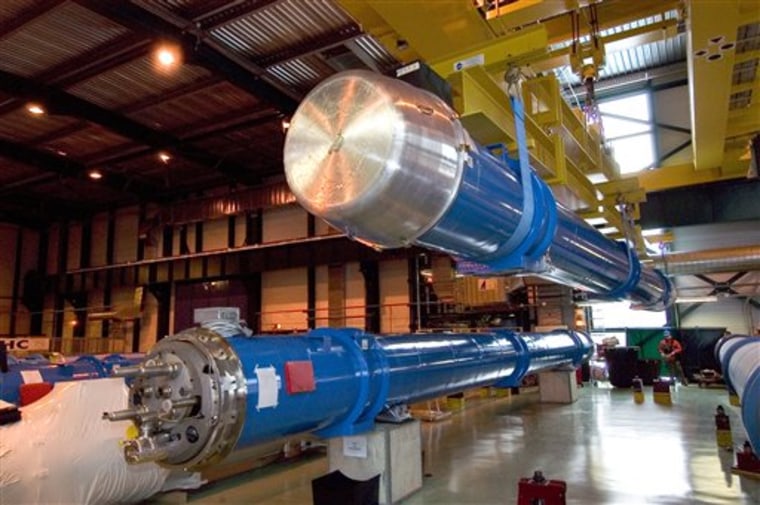Installation of the world’s largest particle physics collider began Monday with the lowering of a massive, superconducting magnet into the circular tunnel housing the new research facility that will draw scientists from all over the world, a spokeswoman said.
The 17-mile tunnel, housing the pipe-like accelerator, is big enough for a subway train and is located 150 to 500 feet under the Swiss-French border.
The aim of the project is to make the particles — in this case protons — travel at nearly the speed of light until they collide, emitting a shower of even smaller particles that will reveal mysteries about the makeup of matter.
The 50-foot-long magnet is the first of 1,232 of the same size that will be placed in the tunnel to speed subatomic particles around the accelerator, said Renilde Vanden Broeck, spokeswoman for the European Organization for Nuclear Research, known by the French initials CERN.
Italian Professor Lucio Rossi, who heads the magnet and superconductor project, said work had fallen four to six months behind because of technical problems in building and installing the huge magnets.
“Now we are catching up,” Rossi told The Associated Press, adding that he hopes “to finish exactly on time” so that the collider can start on schedule at the end of 2007.
The magnet that was lowered Monday weighs more than 38 tons. There will also be hundreds of other, smaller magnets in the tunnel.
The $1.8 billion accelerator, to be known as the Large Hadron Collider, will replace an earlier, less-powerful model that was removed from the tunnel in 2000.
Vanden Broeck said the magnets will be cooled to minus-456 degrees Fahrenheit so they can convey extremely high currents without any loss of energy.
That will enable them to control the path of the protons, which are 2,000 times heavier than the much more easily directed electrons that were used in the earlier accelerator.
The superconducting magnets, chilled by super fluid helium, are a first for CERN, which previously used conventional magnets.
Similar superconducting magnets are in use at the Fermilab outside Chicago, which is currently the world’s most powerful collider, Rossi said. But the CERN magnets will have almost double Fermilab’s magnetic field and the CERN accelerator is several times larger.
“It makes our accelerator approximately eight to 10 times more powerful than the one that is in Batavia, Illinois,” Rossi said.
After the U.S. Congress in 1993 halted construction on the proposed Superconducting Super Collider in Texas, CERN became a focus for world research into matter and into understanding the origins of the universe.
Many American scientists are among the 6,500 scientists from 80 countries — half the world’s researchers specializing in particle physics — who work at CERN.
The lab’s 20 European member countries, as well as observer states like the United States and Japan, make contributions to pay CERN’s yearly budget of about $800 million.
Rossi said he was delighted to be able to proceed with the installation. The delay has left CERN with a massive backlog of equipment — 800 huge magnets that had to be stored outside because there were no buildings large enough to warehouse them.
